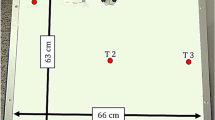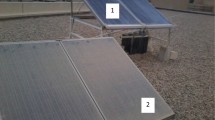Abstract
The decreased efficiency of a photovoltaic panel due to temperature rise during high solar radiation is one of the major drawbacks. The efficiency drop is due to hotness, which restricts the conversion of incident sun rays into electricity by the silicon cells. Thus, a photovoltaic panel has a negative temperature coefficient that increases the current but drops the voltage potential. In this work, water immersion cooling of the photovoltaic panel is studied to improve panel performance. The module is studied with and without water immersion in a tank made up of acrylic material. The photovoltaic (PV) efficiency is determined at different depths of water immersion (10 to 40 mm) inside the acrylic tank. The solar radiation and thermal and electrical parameters of PV are observed at an interval of 60 min, and besides, the solar radiation is also measured. The electrical efficiency without immersion is about 14.24% at solar radiation of about 725 W/m2. The photovoltaic panel was observed at a temperature of around 30 °C during the water immersion. The panel efficiency with an immersion depth of 10, 20, 30, and 40 mm is approximately 15.02%, 15.54%, 14.58%, and 13.95%, respectively. The results show that the immersion of PV panels in tap water 20 mm increases the PV efficiency by 9.1% compared to the PV without water immersion. The presented experimental results are beneficial to the solar community to improve the PV performance without external power.







Similar content being viewed by others
References
Abd-Elhady MS, Serag Z, Kandil HA (2018) An innovative solution to the overheating problem of PV panels. Energy Convers Manag 157:452–459
Al-Nimr MA, Kiwan S, Sharadga H (2018) Simulation of a novel hybrid solar photovoltaic/wind system to maintain the cell surface temperature and to generate electricity. Int J Energy Res 42(3):985–998
Bahaidarah H, Subhan A, Gandhidasan P, Rehman S (2013) Performance evaluation of a PV (photovoltaic) module by back surface water cooling for hot climate. Energy 59:445–453
Bevilacqua P, Bruno R, Arcuri N (2020a) Comparing the performances of different cooling strategies to increase photovoltaic electric performance in different meteorological conditions. Energy 195:116950
Bevilacqua P, Morabito A, Bruno R, Ferraro V, Arcuri N (2020b) Seasonal performances of photovoltaic cooling systems in different weather conditions. J Clean Prod 272:122459
Castanheira AFA, Fernandes JFP, Branco PJC (2018) Demonstration project of a cooling system for existing PV power plants in Portugal. Appl Energy 211:1297–1307
Coleman HW, Steele, JWG (1989) Experimentation and uncertainty analysis for engineers. John Wiley & Sons, New York
Duck BC, Fell CJ, Anderson KF, Sacchetta C, Du Y, Zhu Y (2018) Determining the value of cooling in photovoltaics for enhanced energy yield. Sol Energy 159:337–345
Duraivelu R, Elumalai N (2021) Performance evaluation of a decentralized rooftop solar photovoltaic system with a heat recovery cooling unit. Environ Sci Pollut Res 28(15):19351–19366
Elminshawy NAS, El-Ghandour M, Elhenawy Y, Bassyouni M, El-Damhogi DG, Addas MF (2019) Experimental investigation of a V-trough PV concentrator integrated with a buried water heat exchanger cooling system. Sol Energy 193:706–714
Enaganti PK, Dwivedi PK, Srivastava AK, Goel S (2020) Study of solar irradiance and performance analysis of submerged monocrystalline and polycrystalline solar cells. Prog Photovolt Res Appl 28(7):725–735
Grubišić-Čabo F, Nižetić S, Čoko D, Marinić Kragić I, Papadopoulos A (2018) Experimental investigation of the passive cooled free-standing photovoltaic panel with fixed aluminum fins on the backside surface. J Clean Prod 176:119–129
Hachchadi O, Bououd M, Mechaqrane A (2021) Performance analysis of photovoltaic-thermal air collectors combined with a water to air heat exchanger for renewed air conditioning in building. Environ Sci Pollut Res 28(15):18953–18962
Hernandez-Perez JG, Carrillo JG, Bassam A, Flota-Banuelos M, Patino-Lopez LD (2020) A new passive PV heatsink design to reduce efficiency losses: a computational and experimental evaluation. Renew Energy 147:1209–1220
Hu M, Zhao B, Ao X, Cao J, Wang Q, Riffat S, Su Y, Pei G (2020) An analytical study of the nocturnal radiative cooling potential of typical photovoltaic/thermal module. Appl Energy 277:115625
Jamali S, Nemati A, Mohammadkhani F, Yari M (2019) Thermal and economic assessment of a solar chimney cooled semi-transparent photovoltaic (STPV) power plant in different climates. Sol Energy 185:480–493
Kabeel AE, Abdelgaied M, Sathyamurthy R, Kabeel A (2021) A comprehensive review of technologies used to improve the performance of PV systems in a view of cooling mediums, reflectors design, spectrum splitting, and economic analysis. Environ Sci Pollut Res 28(7):7955–7980
Kazem HA, Al-Waeli AHA, Chaichan MT, Al-Waeli KH, Al-Aasam AB, Sopian K (2020) Evaluation and comparison of different flow configurations PVT systems in Oman: a numerical and experimental investigation. Sol Energy 208:58–88
Kjeldstad T, Lindholm D, Marstein E, Selj J (2021) Cooling of floating photovoltaics and the importance of water temperature. Sol Energy 218:544–551
Kline S, McClintock F (1953) Describing uncertainties in single-sample experiments. Mech Eng 75:3–8
Kumar NM, Subramaniam U, Mathew M, Ajitha A, Almakhles DJ (2020) Exergy analysis of thin-film solar PV module in ground-mount, floating and submerged installation methods. Case Stud Therm Eng 21:100686
Li G, Xuan Q, Pei G, Su Y, Ji J (2018) Effect of non-uniform illumination and temperature distribution on concentrating solar cell - a review. Energy 144:1119–1136
Marinić-Kragić I, Nižetić S, Grubišić-Čabo F, Papadopoulos AM (2018) Analysis of flow separation effect in the case of the free-standing photovoltaic panel exposed to various operating conditions. J Clean Prod 174:53–64
Moffat RJ (1988) Describing the uncertainties in experimental results. Exp Thermal Fluid Sci 1:3–17
Nasrin R, Hasanuzzaman M, Rahim NA (2018) Effect of high irradiation and cooling on power, energy and performance of a PVT system. Renew Energy 116:552–569
Pang W, Cui Y, Zhang Q, Yu H, Zhang L, Yan H (2019) Experimental effect of high mass flow rate and volume cooling on performance of a water-type PV/T collector. Sol Energy 188:1360–1368
Piotrowski LJ, Simões MG, Farret FA (2020) Feasibility of water-cooled photovoltaic panels under the efficiency and durability aspects. Sol Energy 207:103–109
Pratap Singh A, Kumar A, Akshayveer Singh OP (2020) Performance enhancement strategies of a hybrid solar chimney power plant integrated with photovoltaic panel. Energy Convers Manag 218:113020
Preet S (2018) Water and phase change material based photovoltaic thermal management systems: a review. Renew Sust Energ Rev 82:791–807
Rajput UJ, Yang J (2018) Comparison of heat sink and water type PV/T collector for polycrystalline photovoltaic panel cooling. Renew Energy 116:479–491
Ramdani H, Ould-Lahoucine C (2020) Study on the overall energy and exergy performances of a novel water-based hybrid photovoltaic-thermal solar collector. Energy Convers Manag 222:113238
Rosa-Clot M, Rosa-Clot P, Tina GM, Scandura PF (2010) Submerged photovoltaic solar panel: SP2. Renew Energy 35(8):1862–1865
Sainthiya H, Beniwal NS (2020) Comparative analysis of electrical performance parameters under combined water cooling technique of photovoltaic module: an experimental investigation. Energy Sources Part A 42:1902–1913
Sato D, Yamada N (2019) Review of photovoltaic module cooling methods and performance evaluation of the radiative cooling method. Renew Sust Energ Rev 104:151–166
Senthil R (2019) Enhancement of electrical and thermal performance by cooling of solar PV systems. International Journal of Innovative Technology and Exploring Engineering 8(6):420–423
Shahsavar A, Eisapour M, Talebizadehsardari P (2020) Experimental evaluation of novel photovoltaic/thermal systems using serpentine cooling tubes with different cross-sections of circular, triangular and rectangular. Energy 208:118409
Sopian K, Al-Waeli AHA, Kazem HA (2020) Energy, exergy and efficiency of four photovoltaic thermal collectors with different energy storage material. J Energy Storage 29:101245
Teo HG, Lee PS, Hawlader MNA (2012) An active cooling system for photovoltaic modules. Appl Energy 90(1):309–315
Tina GM, Rosa-Clot M, Rosa-Clot P, Scandura PF (2012) Optical and thermal behavior of submerged photovoltaic solar panel: SP2. Energy 39(1):17–26
Zilli BM, Lenz AM, de Souza SNM, Secco D, Nogueira CEC, Junior OHA et al (2018) Performance and effect of water-cooling on a microgeneration system of photovoltaic solar energy in Paraná Brazil. J Clean Prod 192:477–485
Acknowledgements
The authors are grateful to the SRM Institute of Science and Technology for contributing the required infrastructure to carry out this research work.
Availability of data and materials
All data generated or analyzed during this study are included in this published article.
Author information
Authors and Affiliations
Contributions
Baskaran Sivakumar: conceptualization, methodology, investigation. Subramanian Navakrishnan: investigation and data collection, data analysis. Menaka Ravi Cibi: data collection, validation and formal analysis. Ramalingam Senthil: methodology, data curation, writing—original draft preparation, writing, reviewing and editing, supervision.
Corresponding author
Ethics declarations
Ethics approval and consent to participate
The reported studies did not involve human participants and human data.
Consent for publication
This does not involve any individual’s data.
Competing interests
The authors declare no competing interests.
Additional information
Responsible Editor: Philippe Garrigues
Publisher’s note
Springer Nature remains neutral with regard to jurisdictional claims in published maps and institutional affiliations.
Highlights
• The water immersion of solar PV reduces the panel temperature significantly.
• The water immersion depth of 20 mm improves electrical efficiency by about 9.1%.
• Submerged solar PV minimizes the land-dependability installations.
• The immersed solar PV is observed as one of the effective cooling methods.
• An optimum immersion depth of PV is essential for heat dissipation.
Rights and permissions
About this article
Cite this article
Sivakumar, B., Navakrishnan, S., Cibi, M.R. et al. Experimental study on the electrical performance of a solar photovoltaic panel by water immersion. Environ Sci Pollut Res 28, 42981–42989 (2021). https://doi.org/10.1007/s11356-021-15228-z
Received:
Accepted:
Published:
Issue Date:
DOI: https://doi.org/10.1007/s11356-021-15228-z




